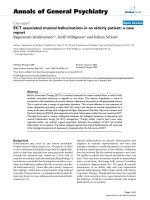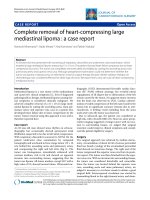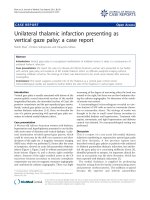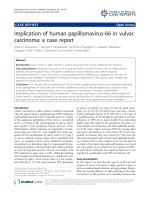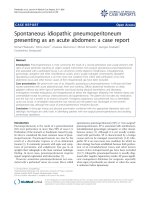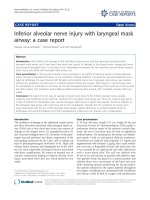Báo cáo y học: " Adrenocortical oncocytic neoplasm presenting with Cushing''''s syndrome: a case report" pot
Bạn đang xem bản rút gọn của tài liệu. Xem và tải ngay bản đầy đủ của tài liệu tại đây (1.01 MB, 5 trang )
BioMed Central
Page 1 of 5
(page number not for citation purposes)
Journal of Medical Case Reports
Open Access
Case report
Adrenocortical oncocytic neoplasm presenting with Cushing's
syndrome: a case report
Ozlem Yersal Kabayegit*
1
, Dilek Soysal
1
, Gonca Oruk
2
, Bahar Ustaoglu
1
,
Umut Kosan
1
, Serife Solmaz
1
and Arzu Avci
3
Address:
1
Department of 1st Internal Medicine, Izmir Ataturk Training Hospital, Izmir, Turkey,
2
Department of Endocrinology, Izmir Ataturk
Training Hospital, Izmir, Turkey and
3
Department of Pathology, Izmir Ataturk Training Hospital, Izmir, Turkey
Email: Ozlem Yersal Kabayegit* - ; Dilek Soysal - ; Gonca Oruk - ;
Bahar Ustaoglu - ; Umut Kosan - ; Serife Solmaz - ;
Arzu Avci -
* Corresponding author
Abstract
Introduction: Oncocytic neoplasms occur in several organs and are most commonly found in the
thyroid, kidneys and salivary glands. Oncocytic neoplasms of the adrenal cortex are extremely rare
and are usually non-functioning.
Case presentation: We report the case of an adrenocortical oncocytic neoplasm with uncertain
malignant potential in a 31-year-old man with Cushing's syndrome. The patient had been operated
on following diagnosis of a 7 cm adrenal mass. Following surgery, the Cushing's syndrome resolved.
The patient is still alive with no metastases one year after the surgery.
Conclusion: Adrenocortical oncocytic neoplasms must be considered in the differential diagnosis
of both functioning and non-functioning adrenal masses.
Introduction
Adrenocortical neoplasms are the most frequent abnor-
malities of the adrenal cortex, but only a small fraction of
patients also present with endocrine disorders [1]. Most of
these lesions are clinically silent and are detected inciden-
tally. The prevalence of adrenal tumors in the general pop-
ulation is around 1%, increasing with age to 6% in the
elderly.
Oncocytic neoplasms are composed of oncocytic tumor
cells, which are characterized by having large, eosi-
nophilic, granular cytoplasm owing to the aberrant accu-
mulation of mitochondria [2]. The most commonly
reported sites for oncocytic neoplasms are the thyroid,
kidneys and salivary glands. Oncocytic neoplasms of the
adrenal cortex are extremely rare. Most adrenocortical
oncocytic neoplasms are benign and non-functioning and
are detected incidentally. We report the case of a patient
with a functioning adrenal oncocytic neoplasm who pre-
sented with Cushing's syndrome.
Case presentation
A 31-year-old man with progressive weight gain and
fatigue for 10 years was admitted to hospital. He had
developed edema of his hands and face and back pain
during the previous two years. Physical examination
revealed a typical cushingoid appearance including a ple-
thoric moon face, truncal and centripetal obesity and
abdominal cutaneous striae (Figure 1, Figure 2, Figure 3).
His blood pressure on admission was 160/90 mmHg.
Published: 13 July 2008
Journal of Medical Case Reports 2008, 2:228 doi:10.1186/1752-1947-2-228
Received: 4 July 2007
Accepted: 13 July 2008
This article is available from: />© 2008 Kabayegit et al; licensee BioMed Central Ltd.
This is an Open Access article distributed under the terms of the Creative Commons Attribution License ( />),
which permits unrestricted use, distribution, and reproduction in any medium, provided the original work is properly cited.
Journal of Medical Case Reports 2008, 2:228 />Page 2 of 5
(page number not for citation purposes)
Laboratory investigations revealed leukocytosis and nor-
mal serum electrolytes and normal fasting and post-pran-
dial glucose levels. Cushing's syndrome was suspected,
and further endocrinological tests were performed to
determine the etiology. Diurnal variation of plasma corti-
sol was not observed. The plasma cortisol level was not
suppressed by 1 mg overnight or by 8 mg of standard dex-
amethasone. Plasma adrenocorticotropic hormone
(ACTH) level was markedly suppressed (less than 10 pg/
ml). Plasma free T3, free T4, thyroid-stimulating hormone
(TSH), follicle-stimulating hormone (FSH), luteinizing
hormone (LH), and urinary catecholamine levels were all
within normal limits. There were no increases in the
plasma concentrations of parathormone, calcitonin, tes-
tosterone, dehydroepiandrosterone sulphate, androstene-
dione or 24-hour urinary calcium excretion (Table 1).
Chest X-ray was normal. Dual-energy X-ray absorptiome-
try (DEXA) scanning demonstrated osteopenia at the
femur head (T score, -2.46). T scores of the trochanter,
Ward's triangle, L3, and L4 were -2.54, -4.07, -4.42 and -
3.36, respectively, compatible with osteoporosis. Com-
puted tomography of the abdomen revealed a 7 cm × 5 cm
mass in the right adrenal gland. The patient underwent
surgery for a right adrenalectomy. The pathologic diagno-
sis was adrenal oncocytic neoplasm with uncertain malig-
nant potential according to the criteria proposed by
Bisceglia et al. [3]. The Weiss score of the tumor was 2 (dif-
fuse architecture and capsular invasion), compatible with
a benign neoplasm.
The tumor measured 7 cm at its greatest dimension,
weighed 105 g and was surrounded by an intact capsule.
The tumor was composed of polygonal oncocytes with
granular, eosinophilic cytoplasm (Figure 4). The tumor
cells were arranged in a diffuse pattern. The mitotic rate
was 1 per 50 high-power fields. There were no atypical
mitotic figures and no necrosis. Capsular invasion was
Plethoric moon face of the patientFigure 1
Plethoric moon face of the patient.
Truncal obesity of the patientFigure 2
Truncal obesity of the patient.
Abdominal cutaneous striae of the patientFigure 3
Abdominal cutaneous striae of the patient.
Journal of Medical Case Reports 2008, 2:228 />Page 3 of 5
(page number not for citation purposes)
identified in one focus. Inhibin and pancytokeratin were
focally positive (Figure 5, Figure 6). The tumor was immu-
noreactive for synaptophysin and negative for p53 (Figure
7).
From these findings, the final diagnosis for this patient
with Cushing's syndrome was of a functioning adrenocor-
tical oncocytic neoplasm.
The Cushing's syndrome improved gradually after the sur-
gery. The patient is still alive with no metastases and is
receiving glucocorticoid replacement therapy 1 year after
the surgery. His blood pressure and electrolyte levels
remain normal.
Discussion
Oncocytic tumors originating from the adrenal cortex are
extremely rare. To date, only 46 cases have been reported,
and include 24 oncocytomas, 6 oncocytic neoplasms of
uncertain malignant potential and 16 oncocytic carcino-
mas. The patients had a wide age range (27 to 74 years)
with a significant female to male predominance. The neo-
plasms varied in size from 2.2 cm to 15 cm and in weight
from 22 g to 865 g. All arose in the adrenal gland with the
exception of two cases, which occurred in heterotopic ret-
roperitoneal adrenal tissue [4,5]. Patients were usually not
initially referred to an oncologist. In all but one case,
oncocytic neoplasms were diagnosed incidentally or dur-
ing investigation for symptoms that were not attributable
to the tumor, such as abdominal pain, hematuria, essen-
tial hypertension, episodic vomiting, ascites and edema of
the lower extremities [6,7]. El-Naggar et al. [8] reported
Table 1: Laboratory evaluation
Patient Normal range
White blood cell (K/μl) 17.3 4 to 10
Calcium (mg/dl) 9.7 9 to 12
Carcinoembryonic antigen (ng/ml) 3.61
24-hour urinary free cortisol (μg/24 hour) 350
Plasma adrenocorticotropic hormone (pg/ml) < 10 7.4 to 55.7
Plasma basal cortisol (μg/dl) 41.45
Cortisol (after 1 mg dexamethasone) (μg/dl) 37.97
Cortisol (after 2 mg dexamethasone) (μg/dl) 13.40
Cortisol (after 8 mg dexamethasone) (μg/dl) 35.08
Free T
3
(pg/ml) 4.65 2.5 to 4.9
Free T
4
(ng/dl) 0.969 0.8 to 1.9
Thyroid-stimulating hormone (μIU/ml) 1.63 0.4 to 5
Neoplasm composed of diffuse oncocytic cellsFigure 4
Neoplasm composed of diffuse oncocytic cells. The
tumor was composed of polygonal oncocytes with granular,
eosinophilic cytoplasm. Hematoxylin and eosin, magnification
×200.
The tumor cell cytoplasms showing focally positive immuno-reactivity for inhibin immunostainingFigure 5
The tumor cell cytoplasms showing focally positive
immunoreactivity for inhibin immunostaining. Immu-
nohistochemical stain, magnification ×400.
Journal of Medical Case Reports 2008, 2:228 />Page 4 of 5
(page number not for citation purposes)
the case of one patient who suffered from abdominal pain
caused by tumor infiltration to the adjacent vena cava and
liver.
Oncocytic neoplasms of the adrenal cortex were non-
functioning with the exception of two cases. Xiao et al. [9]
identified an adrenocortical oncocytoma in a 53-year-old
woman who presented with Cushing's syndrome. Erland-
son and Reuter [10] reported a female patient who was
incidentally found to have a 5 cm virilizing adrenocortical
oncocytoma and a coexisting urinary bladder tumor. After
surgery, this patient's 17-ketosteroid level returned to nor-
mal.
Our patient had a functioning adrenocortical oncocytic
neoplasm. He was symptomatic and admitted to the hos-
pital because of suspected Cushing's syndrome. The labo-
ratory findings were compatible with the syndrome, and
further investigation revealed a mass in the right adrenal
gland. After the surgery, the Cushing's syndrome resolved.
The biologic behavior of adrenocortical neoplasms is the
most important practical problem. A combination of clin-
ical, biochemical and histological features can differenti-
ate benign and malignant adrenocortical tumors. Aside
from the obviously malignant cases in which the diagno-
sis is based on common clinicopathologic features univer-
sally valid for tumors of any site, such as distant
metastases, surgical unresectability and/or invasion of
adjacent organs, the prediction of biologic behavior and
clinical outcome can be difficult. There is no single histo-
logical parameter that is predictive of the clinical outcome
and biologic behavior of adrenocortical oncocytic neo-
plasms. The Weiss system is the most widely used and
accepted histological scheme to distinguish benign from
malignant adrenal tumors [11]. According to this system,
the presence of four or more of the nine criteria (high
mitotic rate, atypical mitoses, high nuclear grade, low per-
centage of clear cells, necrosis, diffuse tumor architecture,
capsular invasion, sinusoidal invasion and venous inva-
sion) indicates a malignant neoplasm. However, the
Weiss criteria have limitations. First, Weiss studied only
43 adrenocortical tumors of which 25 were benign and 18
were malignant tumors according to his classification.
Second, patients with benign tumors in his series had a
longer follow-up period than those with malignant
tumors. Third, tumor tissue could be heterogeneous
within the same lesion. Therefore, the Weiss score, even if
established by experienced pathologists, cannot be com-
pletely reliable. Pohlink et al. [12] reported a patient with
an adrenal incidentaloma, which was initially diagnosed
as benign but on follow-up was reclassified as malignant
because of local recurrence and pulmonary metastases.
Bisceglia et al. [3] proposed new criteria that modified the
Weiss system. According to this system, if the tumor
exhibits any of the major criteria (high mitotic activity,
atypical mitoses or venous invasion), it is considered
malignant; if the tumor exhibits any of the minor criteria
(large size, necrosis, capsular or sinusoidal invasion), it is
considered to have uncertain malignant potential; and
none of these features indicates a benign tumor [3]. In this
case, there were no atypical mitotic figures or venous inva-
sion and the mitotic rate was 1 per 50 high-power fields,
although capsular invasion was present in one focus.
Therefore, this case was diagnosed as oncocytic neoplasm
The tumor cell cytoplasms showing focally positive pancytok-eratin immunostainingFigure 6
The tumor cell cytoplasms showing focally positive
pancytokeratin immunostaining. Immunohistochemical
stain, magnification ×400.
The tumor cell cytoplasms showing focally positive synapto-physin immunostainingFigure 7
The tumor cell cytoplasms showing focally positive
synaptophysin immunostaining. Immunohistochemical
stain, magnification ×400.
Journal of Medical Case Reports 2008, 2:228 />Page 5 of 5
(page number not for citation purposes)
with uncertain malignant potential according to the sys-
tem proposed by Bisceglia et al.
Adrenocortical oncocytomas are generally considered as
benign neoplasms. In 22 of the 25 reported patients for
whom follow-up information was available, no recur-
rence or metastases were observed within a follow-up
period ranging from 1 to 99 months.
Borderline adrenal oncocytomas also seem to have a
benign clinical behavior. Bisceglia et al. [3] reported four
patients with a mean follow-up of 38.75 months (10 to 61
months) with no evidence of the disease. Lin et al. [7]
reported two patients with uncertain malignant potential
with a mean follow-up of 15.5 months (12 to 19 months)
who had not experienced recurrence or metastases.
Recurrence and metastases have been described in
patients with an adrenal oncocytic carcinoma. Kurek et
al.[13] described a patient who exhibited widespread ret-
roperitoneal infiltration 7 years after the removal of an
adrenal tumor. Local invasion into the inferior vena cava
and extension to the right atrium was observed in one case
[6] and to the liver in another [8].
There was no evidence of metastases in our patient. The
tumor was compatible with the diagnosis of an oncocytic
neoplasm with uncertain malignant potential. The mass
was surgically removed and no other therapy was given.
The patient will be followed-up to check for any recur-
rence or metastases every 6 months.
Conclusion
Although rare, adrenocortical oncocytic neoplasms must
be considered among the differential diagnosis of both
functional and non-functional adrenal masses. Clinical,
biochemical and histological features must be evaluated
together to assess the biologic behavior of these tumours.
Abbreviations
ACTH: Adrenocorticotropic hormone; DEXA: Dual-
energy X-ray absorptiometry; FSH: Follicle-stimulating
hormone; LH: Luteinizing hormone; TSH: Thyroid-stimu-
lating hormone.
Competing interests
The authors declare that they have no competing interests.
Consent
Written informed consent was obtained from the patient
for publication of this case report and any accompanying
images. A copy of the written consent is available for
review by the Editor-in-Chief of this journal.
Authors' contributions
OYK conceived of the study, made substantial contribu-
tions to the acquisition of data, drafted the initial manu-
script and revised the draft over the course of submission.
DS coordinated the design and drafting of the initial ver-
sion and revised the draft over the course of submission.
GO carried out endocrinological evaluation of the patient,
made contributions to the acquisition of data and revised
the draft wherever necessary. BU made contributions to
the acquisition of data, participated in study design and
coordination, and helped to draft the manuscript. UK
made contributions to the acquisition of data, partici-
pated in study design and coordination, and helped to
draft the manuscript. SS carried out suppression tests and
helped to draft the manuscript. AA carried out pathologic
assessment and revised the draft where necessary. All
authors read and approved the final manuscript.
References
1. Bornstein SR, Stratakis CA, Chrousos GP: Adrenocortical
tumors: recent advances in basic concepts and clinical man-
agement. Ann Intern Med 1999, 130:759-771.
2. Chang A, Harawi SJ: Oncocytes, oncocytosis, and oncocytic
tumors. Pathol Annu 1992, 27:263-304.
3. Bisceglia M, Ludovico O, Di Mattia A, Ben-Dor D, Sandbank J, Pas-
quinelli G, Lau SK, Weiss LM: Adrenocortical oncocytic tumors:
report of 10 cases and review of the literature. Int J Surg Pathol
2004, 12:231-243.
4. Nguyen GK, Vriend R, Ronaghan D, Lakey WH: Heterotopic
adrenocortical oncocytoma. A case report with light and
electron microscopic studies. Cancer 1992, 70:2681-2684.
5. Poretti D, Mazzarol G, Bonomo G, Casadio C, Bellomi M: Adreno-
cortical oncocytoma: case report. Clin Imaging 2003,
27:426-430.
6. Krishnamurthy S, Ordóñez NG, Shelton TO, Ayala AG, Sneige N:
Fine-needle aspiration cytology of a case of oncocytic adren-
ocortical carcinoma. Diagn Cytopathol 2000, 22:299-303.
7. Lin BT, Bonsib SM, Mierau GW, Weiss LM, Medeiros LJ: Oncocytic
adrenocortical neoplasms: a report of seven cases and
review of the literature. Am J Surg Pathol 1998, 22:603-614.
8. El-Naggar AK, Evans DB, Mackay B: Oncocytic adrenal cortical
carcinoma. Ultrastruct Pathol 1991, 15:549-556.
9. Xiao GQ, Pertsemlidis DS, Unger PD: Functioning adrenocortical
oncocytoma: a case report and review of the literature. Ann
Diagn Pathol 2005, 9:295-297.
10. Erlandson RA, Reuter VE: Oncocytic adrenal cortical adenoma.
Ultrastruct Pathol 1991, 15:539-547.
11. Medeiros LJ, Weiss LM: New developments in the pathologic
diagnosis of adrenal cortical neoplasms. A review. Am J Clin
Pathol 1992, 97:73-83.
12. Pohlink C, Tannapfe A, Eichfeld U, Schmidt F, Führer D, Paschke R,
Koch CA: Does tumor heterogeneity limit the use of the
Weiss criteria in the evaluation of adrenocortical tumors? J
Endocrinol Invest 2004, 27:565-569.
13. Kurek R, Von Knobloch R, Feek U, Heidenreich A, Hofmann R: Local
recurrence of an oncocytic adrenocortical carcinoma with
ovary metastasis. J Urol 2001, 166:985.
